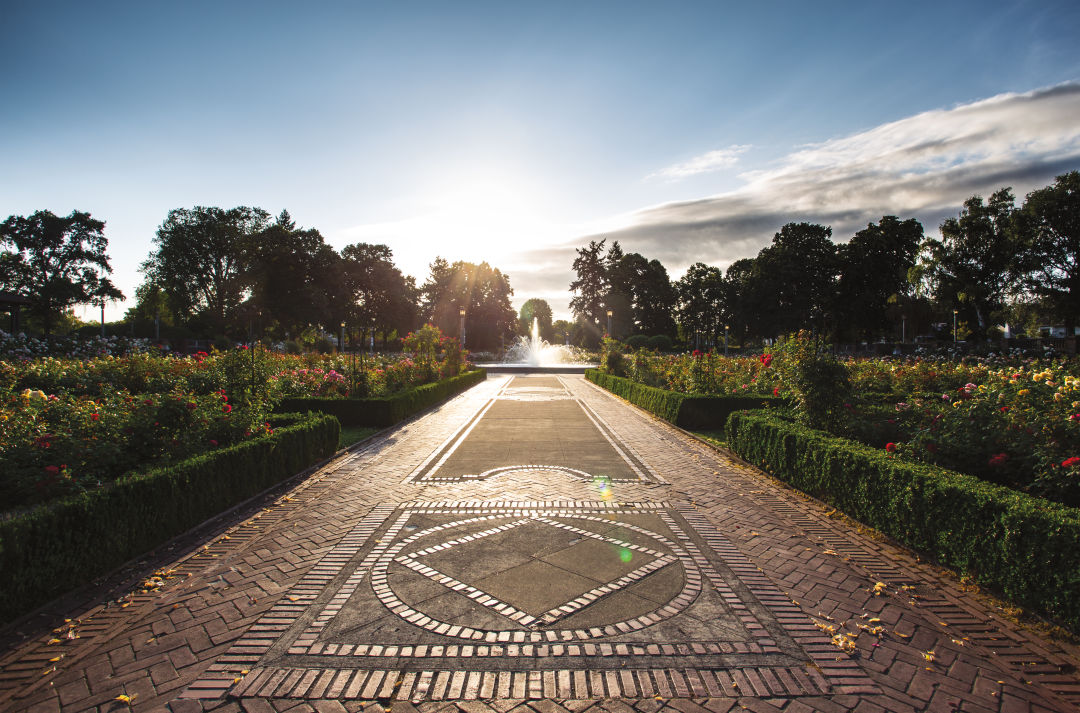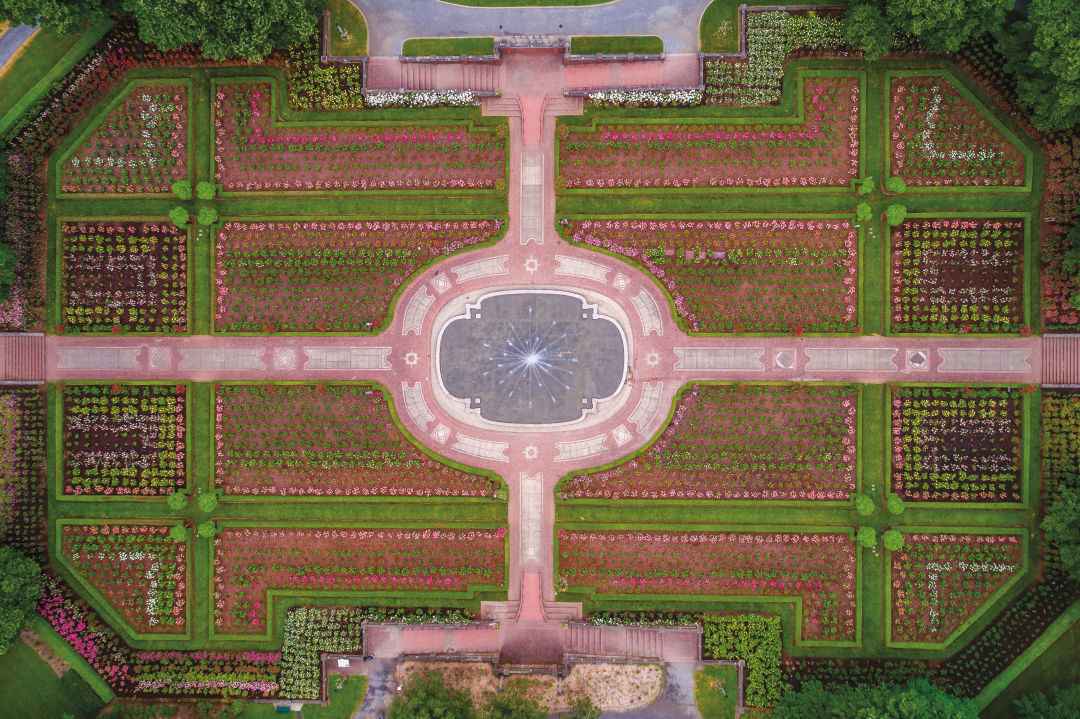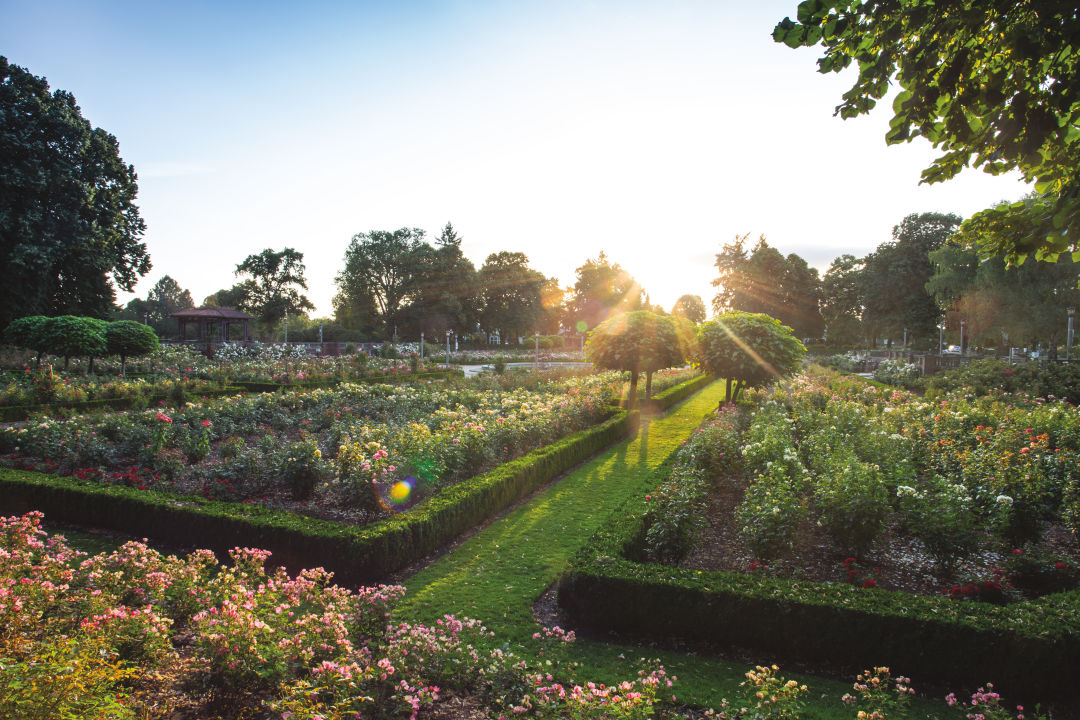The Hidden History of North Portland's Flower-Powered Peninsula Park

Looking east in Peninsula Park’s sunken garden, a Portland take on the City Beautiful movement
Image: Michael Novak
Find yourself near N Ainsworth and Albina in high summer, and you could easily imagine you’ve wandered into a time warp. Is this some turn-of-the-century French estate? No, it’s Peninsula Park and its hidden gem of a sunken rose garden.
Built on a parcel of land once owned by Liverpool Liz, proprietress of a notorious Old Town saloon, the Piedmont neighborhood park was a landmark of pride when it was completed in 1913, and its intricate, European-influenced garden marked a high point in the burgeoning city’s love affair with the rose. The park attracted more than 300,000 visitors in its inaugural year—more than the population of Portland at the time.
In the years leading up to 1905’s Lewis and Clark Centennial Exposition, tens of thousands of Madame Caroline Testout tea roses (a lusty pink French hybrid bred in 1890) had been planted in home gardens and as hedging along Portland’s streets, dazzling visitors to the city and turning Portland’s curbs into a riot of softly fragrant pink blossoms. The Rose Festival was founded in 1907 in collaboration with the Portland Rose Society, and the city once referred to as Stumptown was reveling in a far more glamorous new identity as the City of Roses.
Working off a plan proposed after a 1903 visit by esteemed landscape architect John Charles Olmsted, architects Ellis Lawrence and Ormond R. Bean joined with parks superintendent (and former Olmsted employee) Emanuel Mische (see below) to fashion the site’s former roadhouse and ad-hoc horse racetrack into a 16-acre park featuring an Italian villa–style community center with a courtyard pool and gymnasiums for men and women, as well as a playground, an octagonal bandstand, and paths lit by modern, lantern-style streetlights. Picturesque groves of lindens, oaks, and conifers were planted.

Image: Courtesy Jarred Decker
The park’s crowning glory, designed by Mische, was a symmetrical, formal sunken rose garden. Modeled after classical French rose parterres, it features concrete balustrades, pillars (historically topped with flower-filled urns), and formal brick paths surrounding geometric rose beds. Madame Caroline Testout, newly named as the official rose of Portland, was heavily represented in the original planting. The beds were edged with clipped boxwood and punctuated by catalpa trees and iron trellises festooned with climbing roses. The six-foot, sloped banks, also planted with roses, still encircle the garden’s edges, while the immense decorative fountain at the center of the garden showers arcs of water skyward in summer. Today it’s one of only a few formal, turn-of-the-century rose gardens surviving in the US.
The Portland Rose Society and Rose Festival Association held its official activities in the park at first. Things shifted in 1917 to the much larger new International Rose Test Garden at Washington Park, which had the dual mission of serving as a repository for rose varieties from war-torn Europe and an evaluation site “for the scientific testing outdoors of new roses and the cultivation and development in the open of existing varieties.” (Rose Society members and other flower fans from eastern states must have been thrilled nearly all roses proved fully winter hardy in Portland’s climate.)
Gardeners will be gardeners—as fashions changed, Portland’s love affair cooled, and rosebushes were neglected, torn out, or replaced. Roses in parking strips blocked curbside automobiles or became shaded under the canopies of growing trees. There were periodic revivals, but that gilded era of magnificent, blowsily blooming rose gardens and rose hedges, which once lined hundreds of miles of city streets, had come to a close.
Budget cuts and cultural shifts would bring new challenges. Water was intermittently shut off to the park fountain, and few improvements were made to the garden until 1999, when the central fountain was repaired. New brick access ramps were built in 2008 with donor funding. Three Oregon State University Master Gardener volunteers took a shine to the park, creating the Friends of Peninsula Park Rose Garden in 2012. The group partnered with parks staff to curate, repair, fundraise, and recruit new volunteers.

Pollarded catalpa trees add punctuation at some path crossings.
Image: Michael Novak
In advance of Peninsula Park’s centennial in 2013, some 3,000 new roses were planted to replace ailing bushes. Disease resistance was the top priority, according to Portland Parks and Recreation horticulturist Hillary Maurer, who works closely with the Friends of Peninsula volunteers and board, both on day-to-day care and pruning and on special projects such as the new pollinator garden by the south entry. “We also chose less ‘grabby’ roses near the paths,” she adds.
In addition to such practical concerns, the update was aesthetically faithful to Mische’s original plan for a thoughtfully arranged rose garden. And among more than 50 varieties in the garden today? Four Madame Caroline Testout tea rose bushes—the bloom that started it all.
Emanuel Mische: Portland’s Park-itect
The Olmsted Brothers gained fame designing some of America’s most iconic parks and civic landscapes, including an integrated system of green-spaces in Portland. Locally, a figure just as important to the development of our city’s lush, green lifestyle is Emanuel Tillman Mische, the man hired in 1908 (on John Charles Olmsted’s recommendation) as parks superintendent.
The horticulturalist had studied at the Missouri Botanic School and the Royal Botanic Gardens at Kew, England, before joining Olmsted Brothers in 1898. In Portland, he was charged with overseeing the Olmsted plan for a system of parks connected by tree-lined boulevards, with vistas to the mountains beyond. Mische detailed planting schemes for parks on land purchased after 1907’s $1 million bond, including Laurelhurst, Kenilworth, Sellwood, and Mount Tabor, in addition to Peninsula. He also created planting plans for existing parks like Columbia and Ladd’s Circle that still shape those spaces today.
Following funding frustrations with failed bonds and issues with the new city hierarchy (Portland adopted its commission form of government in 1913), Mische resigned in 1914 but stayed on a year as a consulting landscape architect. He later served as a City Club president and advised on the expansion of Crater Lake National Park before moving out of state. While many of Mische’s and Olmsted’s plans for the city were never to be realized, their mark is still felt on many of the city’s most treasured spaces.
The Oregon Historical Society hosts Madame Caroline Testout: The Rose that Made Portland Famous through June 17.




